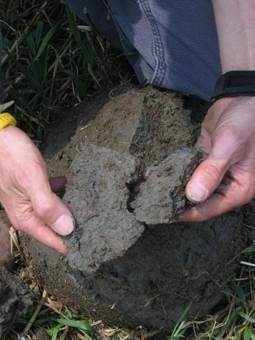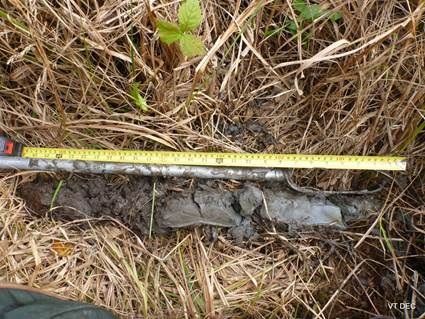
Wetland soil characteristics form when soil is continuously saturated for periods of one or two weeks or more during the growing season. The parent material influences how the soil retains water, and the hydric (wet) soil characteristics that form. The biology of the soil also influences hydric soil characteristics. Under saturated conditions, soil micro-organisms can rapidly use up the oxygen in the soil, which can change its color and appearance.
 If the soil is continually saturated throughout the growing season, the lack of oxygen may severely slow the rate of decay of plant matter and result in the accumulation of a thick layer of peat or muck. Such soils are known as organic soils. All organic soils in Vermont are considered to be hydric, or wetland soils. Muck is an organic soil in which most of the plant material is heavily decomposed and there are still a few recognizable plant fragments. Peat is an organic soil in which most of the plant material is still identifiable. Mucks are usually black, while peats may range in color from brown or reddish brown to black. Many organic soils emit an odor of rotten eggs, resulting from the partial decomposition of plants under waterlogged conditions.
If the soil is continually saturated throughout the growing season, the lack of oxygen may severely slow the rate of decay of plant matter and result in the accumulation of a thick layer of peat or muck. Such soils are known as organic soils. All organic soils in Vermont are considered to be hydric, or wetland soils. Muck is an organic soil in which most of the plant material is heavily decomposed and there are still a few recognizable plant fragments. Peat is an organic soil in which most of the plant material is still identifiable. Mucks are usually black, while peats may range in color from brown or reddish brown to black. Many organic soils emit an odor of rotten eggs, resulting from the partial decomposition of plants under waterlogged conditions.
Soils composed predominantly of mineral matter, such as sand, silt, clay, or loam, are known as mineral soils. If the saturation is of a shorter duration and/or if there is more flow of water through the wetland, there may be little or no accumulation of organic matter. Prolonged saturation leads to the development of gleyed, depleted, or mottled soils. Depleted soils are grey to nearly white in color. Gleyed soil horizons are greenish or bluish gray in color. Soils that are gleyed up to within 18 inches of the surface are hydric soils. Mottled soil horizons form in locations where the water table fluctuates over the course of the year. Soils which contain brown or yellow mottles (spots or specks) within a grayish matrix are hydric soils when the mottling occurs within 18 inches of the surface.

Links of Interest
- NRCS Hydric Soils Homepage. The most current information about hydric soils from the NRCS-USDA Soil Survey Division, including the current definition of a hydric soil, the criteria for hydric soils, the list of field indicators of hydric soils, and the meeting minutes for the National Technical Committee for Hydric Soils.
- Official Soil Series Descriptions. The Official Soil Series Description Query Facility enables you to create a list of soil series meeting specified selection criteria. Soil series may be selected based on various geographic areas of responsibility or use, series status, various dates, or the soil classification.
- Keys to Soil Taxonomy. NRCS-USDA Soil Survey Division key to soil taxonomy in downloadable format.
- NRCS Soil Survey Manual. The Soil Survey Manual provides in a single volume the major principles and practices needed for making and using soil surveys and for assembling and using data related to them. The Manual is intended primarily for use by soil scientists, but can also be used by workers and students who have limited soils experience.
- NRCS Soils Vermont. Find out the status of NRCS County Soil Surveys in Vermont, including where to find on-line surveys, digital, and paper copies.
- Web Soil Survey. Web Soil Survey (WSS) provides soil data and information produced by the National Cooperative Soil Survey. It is operated by the USDA Natural Resources Conservation Service (NRCS) and provides access to the largest natural resource information system in the world. Soil surveys can be used for general farm, local, and wider area planning.
